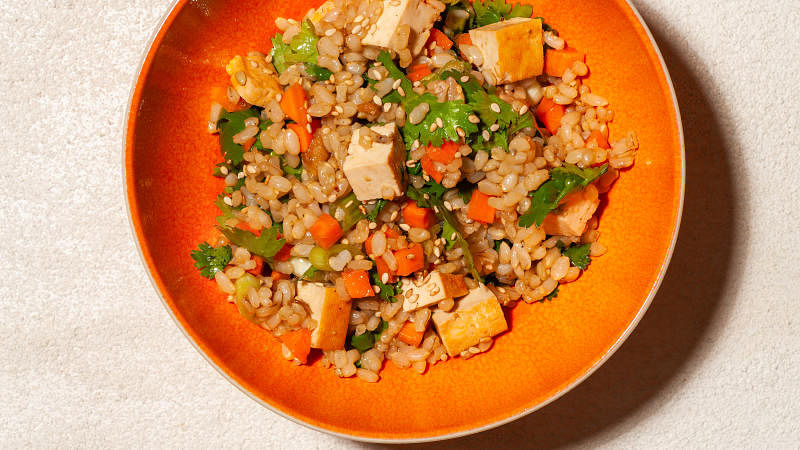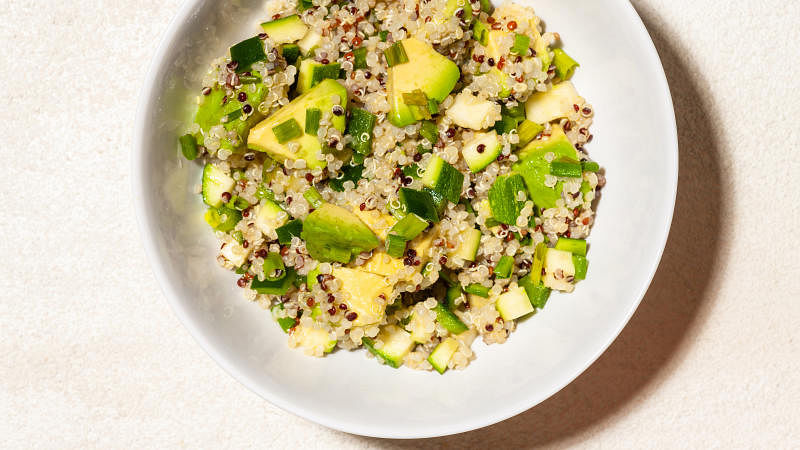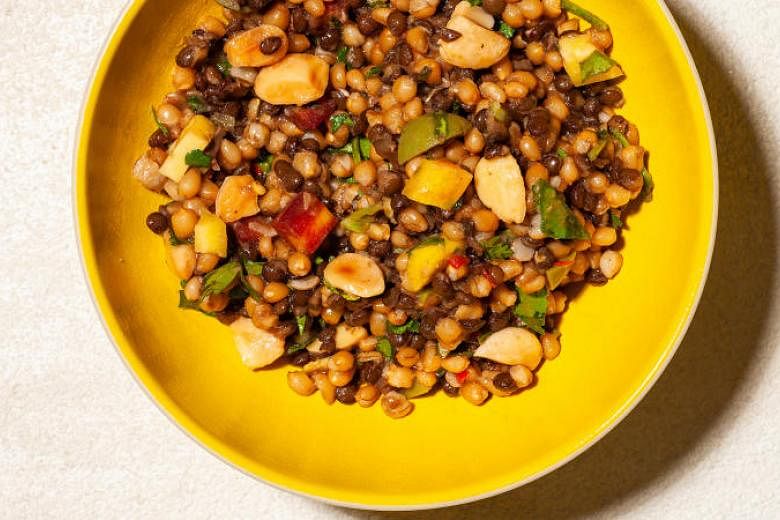(WASHINGTON POST) - There's something comforting about having a pantry stocked with whole grains. Just having them on hand, with intentions to put them to good use, feels nourishing.
But you can't eat intention - and because whole grains are not what I intuitively reach for in the kitchen, my answer is grain salads.
They offer an easy, accessible way both to make use of the whole grains I've been neglecting and to explore the ones I don't know as well.
These room-temperature salads are just right for so many picnics, potlucks, desk lunches, even day hikes and captive dinners on the plane. They won't suffer by being made in advance - the grains will actually absorb more flavour from the dressing as they sit, and, as long as you store add-ins (see "A few notes on assembly" below) on top, they won't lose their textural appeal while they wait.
In the bigger picture, making grain salads provides good lessons in learning how to feel your way through a dish and adapt it to suit your own palate.
They illustrate why, once you're comfortable with a particular method or technique, you don't have to follow a recipe to the letter.
Creating a great grain salad can be organised into four key components:
1. Grains
Virtually any grain can lay the foundation: wheat berries and their ancient relatives farro and einkorn, rye berries, sorghum, quinoa, millet, rice of all kinds. Even teff and amaranth, typically cooked to a porridge, can be refashioned as grain salads with careful preparation. Each offers a distinct set of flavour and texture characteristics, which means you could stick with your other salad components, switch only the grains around and end up with a different result every time. The key, when cooking them, is to err on the side of less water, so your grains end up pearly and distinct. Grains that have taken up too much water will not absorb dressing as well and can lead to a salad that tastes waterlogged.
2. Supporting ingredients (vegetables, herbs, proteins)
They can bring the most expression to the whole and can be a repository for whatever seasonal bounty you have on hand: slivered asparagus, wedges of radish and fresh peas in the spring; halved tomatoes and coins of zucchini in summer; fistfuls of whatever fresh herbs you have in plenty (I like abundant parsley, cilantro, chervil, and smaller amounts of tarragon, marjoram, oregano and thyme).
But they are also perfectly nice with year-round supermarket offerings, such as carrots and scallions - two stalwarts that feature in so many of my cold-weather versions. Depending on their age and freshness, the vegetables can be served raw or they can be dunked in boiling water for a minute or two, which will leave them firm, but diminish signs of crisper-drawer fatigue. If you have more time on your hands, you can also grill or roast them (and if you have leftover grilled or roasted vegetables, a grain salad can be a cozy second home). Proteins can include lentils or beans, baked tofu, cubed or crumbled cheese, hard-cooked eggs. If you eat meat, you could add shredded bits from a leftover roast, or flaked smoked fish.
3. Dressing
You could use a good bottled dressing, but it's easy (and typically better-tasting) to make your own. Because of the earthy foundation laid by the grains, a more acidic-tasting dressing is what I tend to prefer. A red- or white-wine vinaigrette or lemon dressing pairs well with most grains and accompaniments, but the choice of acid can also set a more distinct tone; think sherry vinegar for a salad with a Spanish tilt, or rice vinegar or fresh lime juice for something that leans South-east Asian. Prepared condiments, such as harissa, tapenade, pounded anchovy and garlic, or a Chinese red chile-garlic sauce, are easy routes to extra dimension. Fresh, best-quality oils are important to use here, because any flaws (rancidity, plastic off-flavours) will be impossible to conceal.
4. Add-ins
Toasted nuts or seeds, olives, capers, toasted and crumbled seaweed, pungent or salty cheeses, avocado, chopped dried fruit (apricots and golden raisins are particularly nice, with their sweet-tart balance) are optional, but such a good idea. They add texture and extra pops of flavour, making each bite (and the whole picture) a little more interesting. You can go overboard with these, so try combinations of two or three a salad. Examples: toasted almonds, green olives and golden raisins; seaweed and sesame seeds.
Whatever the ingredients turn out to be, you're always striving for a balance of texture and flavour. The proportions of each component will vary, depending on what you want to emphasise, but a salad composed of equal parts grains and vegetables by volume, with perhaps half as much protein and a modicum of accessory ingredients is a sound guide.
A few notes on assembly:
- Make sure all your moistened ingredients - rinsed vegetables, drained grains and legumes - are dry before combining them with the dressing or you will run the risk of diluting the salad's flavour.
- If you won't be serving the salad right away, hold the ingredients you want to prevent from wilting (scallion greens, arugula, herbs) on top of the salad before folding them in.
- Sturdy leafy greens such as collards and mustards, on the other hand, can be nice to combine in advance, giving the dressing time to soften them somewhat.
- Flavours are fullest at room temperature, so if possible, leave a refrigerated salad out on the counter to warm for an hour or so before serving.
Here are three recipes to get you started: a salad of short-grain brown rice, its sweet, nubby grains, slivered carrots, scallions and cubes of baked tofu slicked with a toasty-tart soya-sesame vinaigrette; a texturally overachieving salad of quinoa, poblano peppers and zucchini, bound by a lemon dressing and crowned with avocado; and a version based on wheat berries and lentils, their profound earthiness lifted via briny green olives, creamy Marcona almonds and a fiery (as you want it) harissa dressing.
For each salad, I've provided a basic version, with suggestions for variations or additions. And now, you take it from here. Before long, you'll need to replenish your grain stores.

Brown Rice Salad With Carrots, Scallions and Baked Tofu
Serves two to three
Because you want the rice at room temperature to make the salad, it's a good idea to cook the rice in advance. To use leftover grains, substitute 2 1/2 cups in place of the 2/3 cup listed here. See VARIATIONS below. Make the dressing just before you're ready to serve; if you whisk it together in advance, it might not re-emulsify with more whisking.
MAKE AHEAD: The rice can be cooked two days in advance and dressed one day in advance. The tofu, scallion greens, cilantro and sesame seeds can be prepared a day in advance and held on top of the rice; mix in before serving.
Ingredients
2/3 cup (uncooked) short- or medium-grain brown rice
1 cup water
2 small carrots, diced
2 medium scallions with greens, whites minced and greens cut on a sharp diagonal, separated
115g baked or smoked tofu, cut into 1.2cm cubes
1 clove garlic, minced
1 1/2 tsp plain rice vinegar (see VARIATIONS below)
1/4 tsp salt
2 1/2 tsp low-sodium soya sauce (see VARIATIONS below)
1 Tbsp plus 2 tsp unrefined sesame oil (see VARIATIONS below)
1 Tbsp toasted sesame oil
1/4 tsp freshly ground white pepper, or more as needed (optional)
1/4 cup cilantro leaves (from 5 to 10 sprigs of cilantro), or more as needed
1 tsp toasted sesame seeds
Steps
- Rinse the rice in a colander until the water runs clear. Drain, then add it to a small, heavy pot with a tight-fitting lid. Add the water and bring to a boil over high heat, then stir once and immediately cover the pot and reduce the heat to low, and cook for 35 minutes, until the rice is cooked (it should still be a little chewy, but not at all hard) and all the water has been absorbed. Leave the rice to cool (or, alternatively, allow the rice to rest for 15 minutes, then spread it on a large plate or two to cool).
- Transfer to a large bowl, along with the carrots, the scallion whites and the tofu.
- Combine the garlic and the rice vinegar in a liquid measuring cup, then add the salt, soya sauce and both sesame oils, whisking to form an emulsified dressing. Pour over the rice and other ingredients in the bowl, add the white pepper, if using, and toss to coat evenly. Stir in the scallion greens, cilantro leaves and sesame seeds, reserving some to scatter on top as a garnish, if desired, and serve.
VARIATIONS: Instead of short-grain brown rice, you could substitute long-grain brown rice, red rice or quinoa; you could use radishes, sweet white turnips, or slivered asparagus in addition to or instead of the carrots. Mustard greens (or another spicy green), cut into thin ribbons, are also delicious here. If you want to add some complexity to the dressing, you could use smoked shoyu for the soya sauce and Chinkiang vinegar for the rice vinegar. Alternatively, if all you have is toasted sesame oil, you can replace the unrefined sesame oil with toasted.

Quinoa Salad With Zucchini, Poblano and Avocado
Serves two to three
Because you want the quinoa at room temperature to make the salad, it's a good idea to cook it ahead of time. Alternatively, you can spread it out on a plate to cool after it has cooked and briefly rested, or use leftover quinoa. To use leftover grains, substitute 2 1/2 cups in place of the 2/3 cup dry listed here. For add-in and swap-out ideas, see below.
MAKE AHEAD: The quinoa can be cooked two days in advance and dressed one day in advance. The vegetables and chives can be prepared a day in advance and held on top of the quinoa; mix in before serving. Cut the avocado just before serving to avoid browning.
Ingredients
2/3 cup dried quinoa
1 cup water
1/2 tsp sea salt
2 tsp fresh lemon juice
1/4 tsp freshly ground black pepper
2 Tbsp extra-virgin olive oil
1 small zucchini, diced
1 poblano pepper, seeded and diced (may substitute green bell pepper)
1/4 cup minced chives (may substitute scallion greens)
Flesh of 1 Hass avocado, cut into 2.5cm chunks
Steps
- Rinse and drain the quinoa, then place in a small, heavy pot with a tight-fitting lid. Add the water; bring to a boil over high heat, then immediately cover and reduce the heat to low. Cook for 20 minutes, until the quinoa is fluffy and all the water has been absorbed. Allow to cool in the pot. (Alternatively, let it rest in the pot for 15 minutes, then spread the quinoa on a large plate or baking sheet to cool.) Dissolve the salt in the lemon juice in a liquid measuring cup, then add the black pepper and oil, whisking to form an emulsified dressing.
- Combine the cooled quinoa in a bowl with the zucchini, poblano, 2 Tbsp of the chives and the dressing, and fold well to combine. Top with the avocado and remaining chives.

Wheat Berry and Lentil Salad With Carrots, Parsley and Harissa
Serves two to three
Because you want the wheat berries at room temperature for this salad, it's a good idea to cook them in advance. Alternatively, you can spread the grain out on a plate or baking sheet to cool after it has cooked and briefly rested, or use leftover wheat berries. To use leftover grains, substitute 2 1/3 cups in place of the 2/3 cup dry listed here. Also, see VARIATIONS below.
MAKE AHEAD: The wheat berries can be cooked two days in advance and dressed one day in advance; same goes for the lentils. The carrots, parsley, almonds and olives can be prepared a day in advance and held on top of the salad; mix in just before serving.
Ingredients
2/3 cup whole wheat berries (see headnote)
3/4 tsp salt
8 cups water
1/2 cup French green, Spanish brown or black beluga lentils
2 carrots, diced
1 Tbsp fresh lemon juice
1 Tbsp homemade or store-bought harissa
3 Tbsp extra-virgin olive oil
1/4 cup coarsely chopped parsley leaves and tender stems, from about 10 sprigs flat-leaf parsley
1/4 cup pitted green olives, sliced or chopped
3 Tbsp Marcona or roasted almonds, coarsely chopped
Steps
- Rinse and drain the wheat berries.
- Combine the drained wheat berries, 1/4 tsp salt and five cups of the water in a medium, heavy-bottomed pot. Bring to a boil over high heat, then reduce the heat to medium, partially cover and cook for 45 minutes to 1 hour, until the wheat berries are tender but still a little chewy. Turn off the heat; let them rest for 15 minutes, then drain well and cool.
- Meanwhile, combine the lentils with the remaining three cups of water in a small, heavy pot. Bring to a boil over high heat, then reduce the heat to medium-low, partially cover and cook for 15 to 20 minutes, until barely tender. Turn off the heat; let the lentils cool in their cooking liquid.
- Combine the cooled wheat berries and the lentils (making sure they are well drained) in a medium bowl with the carrots.
- Dissolve the remaining 1/2 tsp salt in the lemon juice in a liquid measuring cup; whisk in the harissa and then the oil to form an emulsified dressing. Pour over the wheat berries, lentils and carrots, tossing to coat evenly.
- Stir in the parsley, olives and almonds, reserving some for garnish, if desired, and serve.
VARIATIONS: For the wheat berries, you could substitute emmer or einkorn (two ancient wheat varieties in the farro category) or rye berries. In place of or in addition to the carrots, you could use diced fresh or roasted sweet peppers, halved cherry tomatoes or finely slivered greens such as collards or arugula, or even leftover roasted vegetables. You could also swap the parsley for cilantro, or replace the lentils with chickpeas (if using canned, rinse and drain well before combining).

